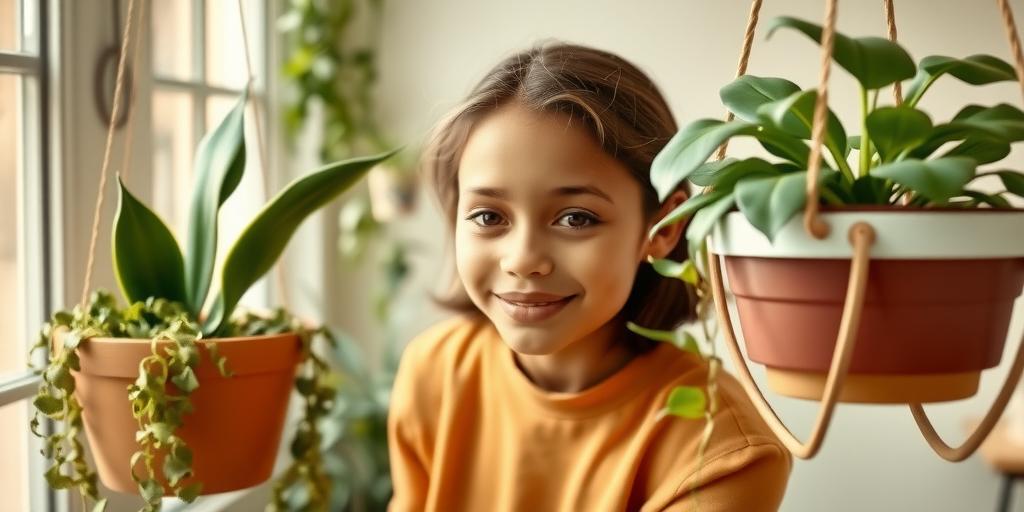
Safe, Non-Toxic Hanging Plants for Homes with Pets and Kids (2025)
Discover the best safe, non-toxic hanging plants for homes with pets and kids! Learn which plants are pet-friendly, easy to care for, and perfect for indoor air purification.
Introduction
Did you know that some common houseplants can be toxic to pets and children? If you love greenery but worry about safety, you’re not alone! Hanging plants are a fantastic way to add life to your home while keeping them out of reach of curious hands and paws. In this guide, we’ll explore the best non-toxic hanging plants that are beautiful, low-maintenance, and safe for your furry friends and little ones. Let’s dive in!
The Dangers of Toxic Plants for Pets (Dogs, Cats) and Children
Many common houseplants can pose serious risks to pets and small children. Dogs and cats, in particular, are curious creatures that may chew on leaves, stems, or even soil, leading to potential poisoning. Symptoms can range from mild irritation to severe vomiting, diarrhea, or even organ failure in extreme cases.
For children, especially toddlers who explore the world by putting things in their mouths, toxic plants can be just as hazardous. Even plants that are only mildly toxic can cause discomfort, drooling, or skin irritation. That’s why it’s crucial to choose non-toxic alternatives that won’t harm your furry friends or little ones.
Benefits of Hanging Plants: Space-Saving, Aesthetic Appeal, and Air Purification
Hanging plants are a fantastic way to bring greenery into your home without sacrificing floor space. They add a touch of nature to any room, whether you have a small apartment or a spacious house. Plus, their cascading vines and lush foliage create a stunning visual effect, making them a favorite among interior design enthusiasts.
Beyond aesthetics, many hanging plants also help purify the air by removing toxins and increasing oxygen levels. This makes them a great addition to bedrooms, living rooms, and even home offices. And when you choose non-toxic varieties, you get all these benefits without worrying about accidental ingestion.
How Non-Toxic Plants Contribute to a Healthier Home Environment
A home filled with safe, non-toxic plants is a healthier one—especially for families with pets and kids. These plants eliminate the risk of poisoning while still offering the same air-purifying and mood-boosting effects as other houseplants.
Additionally, non-toxic plants reduce stress for pet owners and parents. You won’t have to constantly monitor your pets or children around the greenery, allowing everyone to enjoy the space freely. Plus, many pet-safe plants are also low-maintenance, making them perfect for busy households.
Top 10 Safe, Non-Toxic Hanging Plants for Pets and Kids
Spider Plant – Hardy, Air-Purifying, and Completely Safe
Spider plants are one of the best choices for pet-friendly homes. They’re incredibly resilient, thrive in indirect light, and help filter indoor air pollutants. Even if your cat takes a nibble (which they often do), there’s no need to worry—it’s completely non-toxic.
Boston Fern – Lush Foliage, Great for Humidity
With its feathery fronds, the Boston fern adds a touch of elegance to any space. It loves humidity, making it perfect for bathrooms or kitchens. Best of all, it’s safe for pets and kids, so you can hang it anywhere without concern.
Ponytail Palm – Pet-Friendly and Drought-Resistant
Despite its name, the ponytail palm isn’t a true palm—it’s actually a succulent. Its thick trunk and long, curly leaves make it a unique addition to your plant collection. It’s also drought-tolerant, so it’s great for forgetful waterers.
String of Hearts – Beautiful Trailing Vines, Non-Toxic
This delicate plant features heart-shaped leaves that cascade beautifully from hanging pots. It’s a favorite for boho and minimalist decor, and since it’s non-toxic, it’s safe for curious pets and children.
Peperomia – Compact and Safe for Pets
Peperomias come in many varieties, all of which are pet-safe. Their compact size and interesting leaf patterns make them ideal for small spaces. They thrive in moderate light and require minimal care.
Baby’s Tears – Delicate and Harmless If Ingested
Baby’s Tears is a soft, trailing plant that looks stunning in hanging baskets. While it prefers a bit more moisture than some other plants, its non-toxic nature makes it a great choice for homes with pets.
Burro’s Tail (Sedum morganianum) – Pet-Safe Succulent
This succulent’s trailing stems are covered in plump, blue-green leaves. It’s drought-resistant and thrives in bright light. Since it’s non-toxic, you won’t have to worry if your pet takes a curious bite.
Calathea (Prayer Plant) – Non-Toxic and Visually Striking
Calatheas are known for their vibrant, patterned leaves that move throughout the day. They prefer indirect light and higher humidity, making them perfect for bathrooms. Plus, they’re completely safe for pets.
Hoya (Wax Plant) – Safe and Low-Maintenance
Hoyas are beloved for their waxy leaves and fragrant flowers. They’re easy to care for and can tolerate some neglect. Since they’re non-toxic, they’re a worry-free choice for pet owners.
Staghorn Fern – Unique, Non-Toxic, and Easy to Care For
Staghorn ferns are typically mounted on boards or placed in hanging baskets. Their unusual antler-like fronds make them a conversation starter, and they’re completely safe for pets and kids.
How to Care for Pet-Safe Hanging Plants
Light Requirements: Best Spots for Indirect vs. Direct Sunlight
Most hanging plants prefer bright, indirect light. Spider plants, pothos (though toxic), and hoyas do well near east or north-facing windows. Succulents like burro’s tail need more direct sunlight, so a south-facing window is ideal.
Watering Tips: Avoiding Overwatering and Root Rot
Overwatering is a common mistake. Let the top inch of soil dry out before watering again. Ferns and baby’s tears need more frequent watering, while succulents and hoyas prefer drying out between waterings.
Soil and Fertilization: Best Mixes for Healthy Growth
Use well-draining soil to prevent root rot. A mix of potting soil with perlite or orchid bark works well for most plants. Fertilize monthly during the growing season (spring and summer) with a diluted liquid fertilizer.
Pruning and Maintenance: Keeping Plants Lush and Thriving
Regularly trim dead or yellowing leaves to encourage new growth. For trailing plants like string of hearts, occasional pruning helps maintain a full, bushy appearance.
Creative Ways to Display Hanging Plants Safely
Choosing Sturdy Hooks and Hangers to Prevent Accidents
Make sure your hanging hardware can support the weight of the plant, especially as it grows. Ceiling hooks should be securely anchored to avoid falls.
Macramé Hangers vs. Wall-Mounted Brackets
Macramé hangers add a bohemian touch, while wall-mounted brackets offer a sleeker look. Choose based on your decor style and the plant’s weight.
Ideal Heights to Keep Plants Away from Pets and Kids
Hang plants high enough that pets can’t reach them—especially if you have a curious cat. For kids, ensure the plant is out of reach or in a room they don’t frequently access.
Combining Multiple Plants for a Stunning Indoor Jungle Effect
Mix different textures and trailing lengths for a lush, layered look. Pair a spider plant with a string of hearts and a staghorn fern for a dynamic display.
Common Toxic Plants to Avoid in Pet and Kid-Friendly Homes
Pothos – Toxic to Cats and Dogs
Though popular, pothos contains calcium oxalate crystals that can cause mouth irritation and vomiting in pets.
Philodendron – Can Cause Irritation If Ingested
Similar to pothos, philodendrons are toxic to pets and can lead to swelling and digestive issues.
English Ivy – Harmful to Pets
Ingesting English ivy can cause vomiting, diarrhea, and even breathing difficulties in pets.
Sago Palm – Extremely Dangerous for Animals
All parts of the sago palm are toxic, especially to dogs, and can cause liver failure.
Aloe Vera – Mildly Toxic to Pets
While great for humans, aloe vera can cause vomiting and lethargy in pets if ingested.
By choosing non-toxic hanging plants and displaying them safely, you can enjoy a green, vibrant home without compromising the well-being of your pets and children.
Conclusion
Creating a green, vibrant home doesn’t mean compromising safety! By choosing non-toxic hanging plants, you can enjoy lush foliage without worrying about your pets or kids. From the easy-care Spider Plant to the elegant String of Hearts, there are plenty of stunning options to explore. Ready to transform your space? Pick a few pet-safe plants and start hanging them today!
